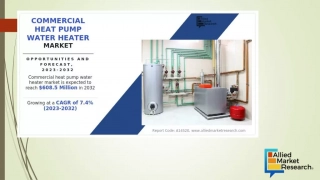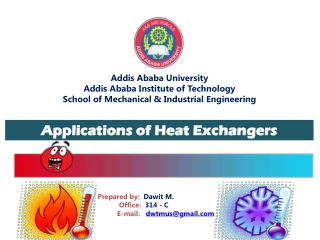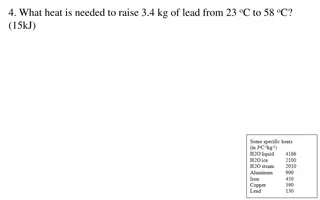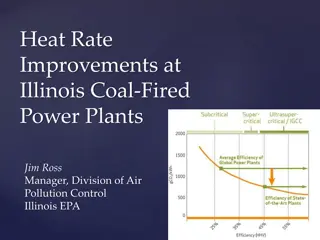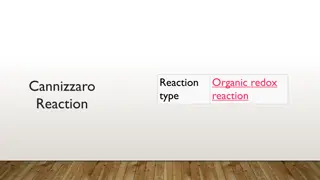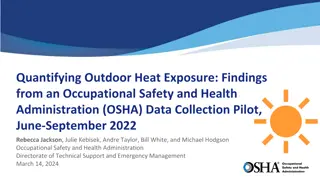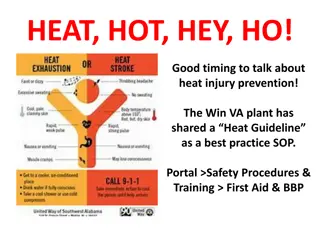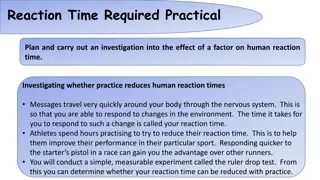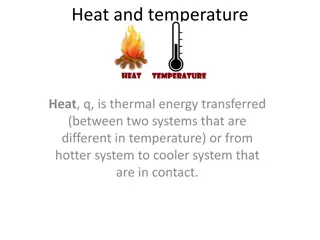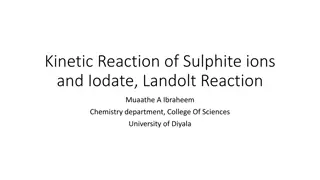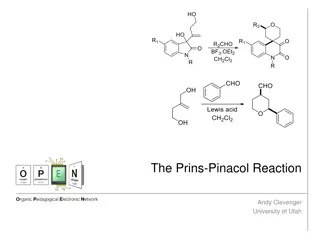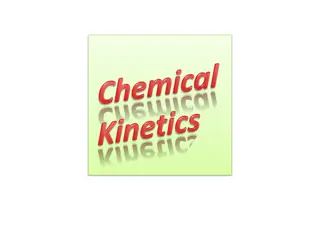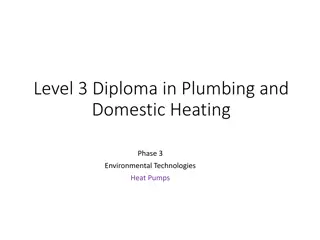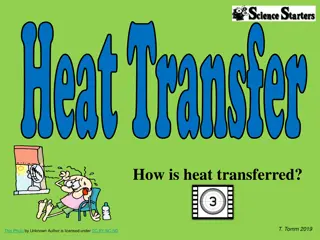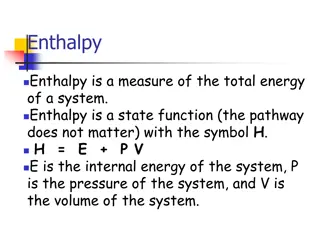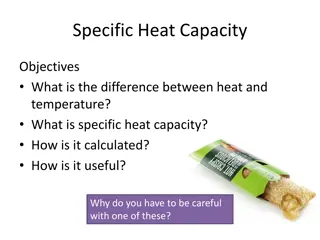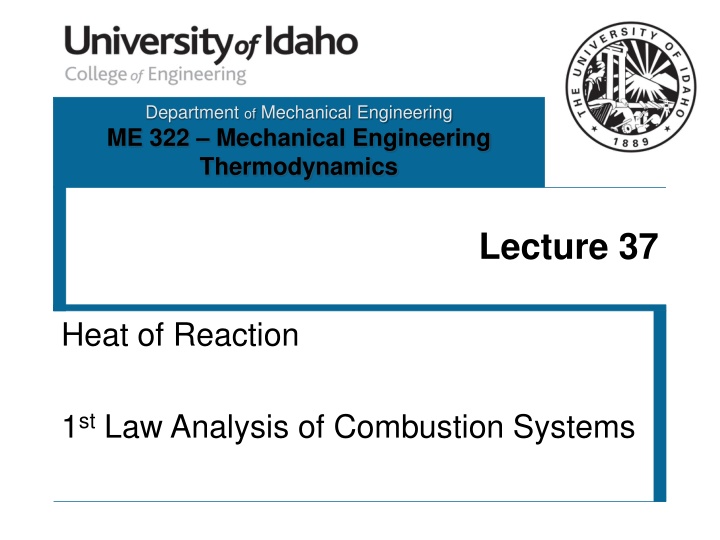
Mechanical Engineering Thermodynamics: Heat of Reaction Analysis
Explore the concepts of heat of reaction, combustion systems analysis, resolving datum state problem, enthalpy of formation, and EES values in the context of mechanical engineering thermodynamics lectures. Understand the application of the First Law in combustion systems and the significance of enthalpy values for stable elements at the standard reference state.
Download Presentation

Please find below an Image/Link to download the presentation.
The content on the website is provided AS IS for your information and personal use only. It may not be sold, licensed, or shared on other websites without obtaining consent from the author. If you encounter any issues during the download, it is possible that the publisher has removed the file from their server.
You are allowed to download the files provided on this website for personal or commercial use, subject to the condition that they are used lawfully. All files are the property of their respective owners.
The content on the website is provided AS IS for your information and personal use only. It may not be sold, licensed, or shared on other websites without obtaining consent from the author.
E N D
Presentation Transcript
Department of Mechanical Engineering ME 322 Mechanical Engineering Thermodynamics Lecture 37 Heat of Reaction 1stLaw Analysis of Combustion Systems
Combustion System Analysis Consider the complete combustion of octane in 150% theoretical air, Q C8H18 Combustion Chamber Products (p) PTA = 150% In the previous lecture, we found the balanced reaction, C H + 18.75(O + 3.76 N ) 8CO + 9H O + 6.25O + 70.5N 8 18 2 2 2 2 2 2 The First Law applied to the system identified above is, ( a a Q n h = ) + n h n h f f p p p 2
Combustion System Analysis Q C8H18 Combustion Chamber Products (p) PTA = 150% C H + 18.75(O + 3.76 N ) 8CO + 9H O + 6.25O + 70.5N ) f f p p p 8 18 2 2 2 2 2 2 ( = + Q a a n h n h n h combustion products reactants (air and fuel) Potential issue: There are no h values (except for O2 and N2). This has the potential to cause a datum state problem. 3
Resolving the Datum State Problem In combustion calculations, the enthalpy of all stable* elements is defined as zero at the standard reference state (SRS), ( ( ) 25 C = = 298.15 K at 0.1 MPa 1 atm ) 77 F 536.67 R at 14.5 psia 1 atm * Stable means chemically stable at the SRS. For example, diatomic oxygen (O2) is stable at the SRS. Monatomic oxygen (O) is not stable at the SRS. 4
Enthalpy of Formation The enthalpy of a compound at the standard reference state Heat released in an exothermic reaction (or absorbed in an endothermic reaction) when a compound is formed from its elements. (Elements and compound at the SRS) fh = 0 = Q n h C C n h n h Example Methane CH CH H H 4 4 2 2 n n n Q H = C h h h Q 2 CH C H n n 4 2 C CH CH CH 4 4 4 CH4 25 C 1 atm 25 C 1 atm Q = 0 f h h 2H2 CH ,CH n 4 4 CH 4 5
Enthalpy of Formation Values Using EES* *Unit setting = molar 7
Enthalpy of Formation Values Results ... Conclusion:EES uses the SRS as the datum state for enthalpy for the ideal gases! Therefore, enthalpy of formation values can be calculated from EES using the ideal gas substances (except AIR) 8
Enthalpy Values in Combustion What do we know so far? 1. The enthalpy of a stable element at the SRS is 0 2. The SRS is 25 C, 0.1 MPa 3. The enthalpy of a compound at the SRS is the enthalpy of formation (Table 15.1 or from EES) 9
Enthalpy Values at Other States The enthalpy of a component at any temperature in a combustion process can be evaluated by, ( ) = + 0 f i h T h h , i i Accounts for the enthalpy difference relative to the SRS ( ) ( ) ( ) = + 0 f i h T h h T h T , i i i SRS How is the enthalpy difference in brackets determined?? 10
Enthalpy Values at Other States ( ) ( ) ( ) = + 0 f i h T h h T h T , i i i SRS Three possibilities ... 1. If the heat capacity of the component can be assumed constant, ( ) ( ) = + 0 f i h T h c T T , , i p i SRS 2. If the constant heat capacity assumption is not accurate enough, then use the ideal gas tables (Table C.16c). In this case the datum state for the table does not have to match the enthalpy of formation. 3. Use a set of property tables for all components that has all enthalpy values referenced to the SRS. Does such a thing exist? 11
Enthalpy Values at Other States Exploring Option 3 from the previous slide ... ( ) ( ) ( ) = + 0 f i h T h h T h T , i i i SRS If a thermodynamically consistent set of tables exists, then ( ) = 0 h h T , f i i SRS Therefore the enthalpy of the component could simply be looked up in a table at the given temperature, ( ) i h T ( ) = h T i If something like this were available ... combustion calculations would be EESy! 12
Enthalpy Values at Other States ALL of the ideal gas enthalpy reference states (except for the ideal gas AIR ) in EES are referenced to the SRS! This is from the EES Help Menu for the ideal gas CO2 ... All other ideal gases in EES (except AIR) say the same thing! Significance: Combustion calculations just became EESy! 13
Heat of Reaction Consider an aergonic combustion process as shown below Q Fuel Products (P) Combustion Chamber Reactants (R) Air The First Law applied to this system results in, = Q nh nh i i i i P R Dividing by the molar flow rate of the fuel, n n Q = = i i q h h i i n n n P R fuel fuel fuel 14
Heat of Reaction n n Q = = i i q h h i i n n n P R fuel fuel fuel The molar flow rate ratios are the molar coefficients from the balanced combustion reaction! Therefore, Q = = q h h i i i i n P R fuel This is known as the molar heat of reaction. 15
Heating Values of Fuels Given: Gaseous octane (C8H18) is burned completely in 100% theoretical air. The reactants and the products are at the SRS. Q C H 8 18 Products T = Combustion Chamber = T T R SRS T P SRS = PTA 100% Find: The heat released during this combustion process per mole of fuel for the following cases, (a) the water in the products is all vapor (b) the water in the products is all liquid 16
Q Heating Values C H 8 18 Products T = Combustion Chamber = T T R SRS T P SRS = The system boundary is drawn around the combustion chamber. Applying the First Law results in, Q = PTA 100% nh nh i i i i P R Dividing both sides of this equation by the molar flow rate of the fuel, n Q h n n n = i i h i i n P R fuel fuel fuel Number of moles of reactant per mole of fuel Number of moles of product species per mole of fuel How are these found? 17
Q Heating Values C H 8 18 Products T = Combustion Chamber = T T R SRS T P SRS = PTA 100% The molar flow rate ratios on the previous slide are the molar coefficients from the balanced combustion reaction (for one mole of fuel)! Therefore, n n Q Q = = = i i h h q h h i i i i i i n n n n P R P R fuel fuel fuel fuel Notice: PTA = 100% means stoichiometric combustion Observations ... 1. The importance of being able to balance the combustion reaction is evident! 2. As long as the combustion process is aergonic, the First Law will be as written above, independent of the conditions in and out of the combustion chamber! 18
Q Heating Values C H 8 18 Products T = Combustion Chamber = T T R SRS T P SRS For the complete combustion of normal octane in 100% theoretical air, we previously found, = PTA 100% C H + 12.5(O + 3.76 N ) 8CO + 9H O + 47N 8 18 2 2 2 2 2 Applying the First Law to the system, Q = = q h h i i i i n P R fuel Q ( ) ( ) = = + + + + + 3.67 q h h h h h h h 1 CO 2 H O 4 O 5 N C H 0 O N n 2 2 2 2 8 18 2 2 fuel Q ( ) = = + q h h h 1 ,CO 2 ,H O ,C H f f f n 2 2 8 18 fuel 19
Q Heating Values C H 8 18 Products T = Combustion Chamber = T T R SRS T P SRS = PTA 100% C H + 12.5(O + 3.76 N ) 8CO + 9H O + 47N 8 18 2 2 2 2 2 Q ( ) = = + q h h h 1 ,CO 2 ,H O ,C H f f f n 2 2 8 18 fuel Now we have an interesting problem. Is the water liquid or gas (or both)? 20
Q Heating Values C H 8 18 Products T = Combustion Chamber = T T R SRS T P SRS = PTA 100% Let s consider both extremes (1) the H2O is all vapor and (2) the H2O is all liquid. C H + 12.5(O + 3.76 N ) 8CO + 9H O + 47N 8 18 2 2 2 2 2 Q ( ) = = + q h h h 1 ,CO 2 ,H O ,C H f f f n 2 2 8 18 fuel All vapor water ... MJ kmol MJ kmol MJ kmol MJ kmol Q ( ) 8 ( ) 9 = = 393.522 + 241.827 5,116.172 = 208.447 q n fuel All liquid water ... MJ kmol MJ kmol MJ kmol MJ kmol Q ( ) 8 ( ) 9 = = 393.522 + 285.838 5,512.271 = 208.447 q n fuel 21
Q Heating Values C H 8 18 Products T = Combustion Chamber = T T R SRS T P SRS = PTA 100% All vapor water ... Q q n MJ = = Lower Heating Value (LHV) 5,116.172kmol fuel All liquid water ... MJ Q = = Higher Heating Value (HHV) 5,512.271kmol q n fuel Observations ... 1. The reactants and products are at the SRS 2. The reaction occurs with PTA = 100% ( i = i ) 3. The difference between the HHV and the LHV is the enthalpy of vaporization of water! 22
Heating Values q 1 mol fuel Products (vapor H2O) TSRS PSRS LHV TSRS, PSRS h H O H O , fg Stoichiometric air 2 2 Products (liquid H2O) HHV ( ) = + HHV LHV h H O H O , fg 2 2 23
Heating Values The heating values represent the maximum possible heat transfer that can occur per mole of fuel. The reactants and products are at the SRS The HHV represents fully condensed water vapor The LHV represents all water vapor These values provide a basis for the combustion efficiency, Actual heat transferred per mole of fuel HHV or LHV = comb 24
Q Example C H 8 18 Products T = Combustion Chamber = T T R SRS T P SRS = PTA 100% Back to our problem ... Is there liquid water in the products at the SRS? If so, how much? C H + 12.5(O + 3.76 N ) 8CO + 9H O + 47N 8 18 2 2 2 2 2 Will water condense? 9 = = 0.1406 y w 8 9 47 + + ( )( ) = = = = 0.1406 0.1 MPa 0.01406 MPa 14.06 kPa P y P w w 52.6 C T dp Since TSRS < Tdp, water will condense 25
Q Example C H 8 18 Products T = Combustion Chamber = T T R SRS T P SRS = PTA 100% How much water will condense? At TSRS = 25 C, the mole fraction of water vapor in the products is, C H + 12.5(O + 3.76 N ) 8CO + 9H O + 47N 8 18 2 2 2 2 2 n = v y v + + 8 47 n v The mole fraction of the water vapor at 25 C can be found, 0.03142 bar 1.01325 bar P P = = = 0.03101 w y w 26

